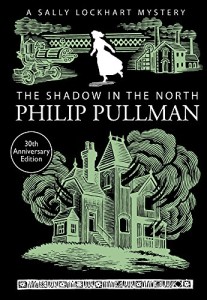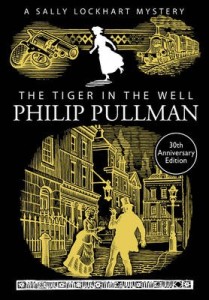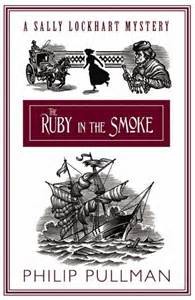The Ruby in the Smoke certainly doesn’t waste any time in getting our attention:
On a cold, fretful afternoon in early October, 1872, a hansom cab drew up outside the offices of Lockhart and Selby, Shipping Agents, in the financial heart of London, and a young girl got out and paid the driver . . . Her name was Sally Lockhart; and within fifteen minutes, she was going to kill a man.
From this arresting opening, the story moves briskly along, following Sally as she tries to figure out what the deadly phrase “The Seven Blessings” means, the real circumstances of her father’s death, and why her own life appears to be in danger. Along the way she makes the fortuitous acquaintance of Frederick Lockhart, a young photographer, and his actress sister Rosa, who provide her with a job as a bookkeeper and a welcome alternative to living with her odious aunt.
This was Pullman’s second published children’s book, and like his first, Count Karlstein, was based on a play that he wrote for his middle-school students. One can easily imagine it on the stage, with its swift scene changes, colorful characters, and dramatic dialogue. It is strongly reminiscent of the more sensationalistic Sherlock Holmes stories (Pullman also wrote a play called “Sherlock Holmes and the Limehouse Horror”), with its cursed jewel, opium dens, and vaguely ominous Chinese secret society. It’s a confection, an exuberant and unapologetic melodrama, one that is rescued from banality by Pullman’s skill in handling these time-worn elements and making them feel fresh and exciting again.
 In The Shadow in the North, Sally has grown up. A strong, independent woman, she runs her own financial consulting business in the City of London. Fred wants to marry her, but she hesitates because she balks at the notion of all her property automatically becoming his, at least until the Married Woman’s Property Act is passed. In the meanwhile, another deadly plot surfaces to lead her into danger: who is behind the mysterious North Star company, and what exactly are they manufacturing? Fred is engaged in a seemingly unrelated investigation of a music-hall magician who can’t quite explain why he is the targetof so many homicide attempts. As the two strands come together, Sally and Fred are drawn deeper into danger than ever, and closer to one another.
In The Shadow in the North, Sally has grown up. A strong, independent woman, she runs her own financial consulting business in the City of London. Fred wants to marry her, but she hesitates because she balks at the notion of all her property automatically becoming his, at least until the Married Woman’s Property Act is passed. In the meanwhile, another deadly plot surfaces to lead her into danger: who is behind the mysterious North Star company, and what exactly are they manufacturing? Fred is engaged in a seemingly unrelated investigation of a music-hall magician who can’t quite explain why he is the targetof so many homicide attempts. As the two strands come together, Sally and Fred are drawn deeper into danger than ever, and closer to one another.
Even twistier and trickier than its predecessor, The Shadow in the North is equally entertaining. Pullman also continues to catalogue a wide array of Victoriana, from spiritualism to railroads to feminism to early motion photography. It can hardly be considered a serious historical effort — and I have to question the plausibility of Sally’s career, inspiring though it may be. But it does give young readers a vivid entree into the period, one that can be tempered by further reading later. For me, this was probably the first step on a path that led me to a college degree in English literature and a thesis on Charlotte Bronte. Fellow feisty orphan Jane Eyre is certainly one of Sally’s ancestresses.
 The Tiger in the Well takes place a couple of years later, and Sally is now a mother. Her idyll of independence is shattered when she receives a summons that claims that her daughter belongs to a man she has never met, who now wants to dissolve their supposed marriage and claim his child. She embarks on a desperate quest to prove him wrong, in which she gains an unlikely supporter: a Jewish Socialist writer, who has charisma to burn. Can they defeat the evil from Sally’s past that has arisen to haunt her?
The Tiger in the Well takes place a couple of years later, and Sally is now a mother. Her idyll of independence is shattered when she receives a summons that claims that her daughter belongs to a man she has never met, who now wants to dissolve their supposed marriage and claim his child. She embarks on a desperate quest to prove him wrong, in which she gains an unlikely supporter: a Jewish Socialist writer, who has charisma to burn. Can they defeat the evil from Sally’s past that has arisen to haunt her?
In this novel, Pullman aims to take a giant step into more serious, adult themes and situations. In doing so, he sometimes loses the verve that gave much of the charm to the first two books. When a social worker literally takes Sally on a tour of the dreadful living conditions in the East End, didacticism threatens to outweigh drama. (Of course, this may simply be an homage to Dickens, who did exactly the same thing.) The violence, both actual and threatened, is several degrees crueller and more painful to imagine. Sally’s anguish is excruciating, and the fate Pullman posits for Sally’s little daughter is horrible to contemplate. Perhaps that’s why this was always my least favorite of the three books.
Still, once you start reading, it’s impossible to put down, as are the first two. Pullman’s talent as a storyteller is evident from the beginning to the end. If you haven’t yet met Sally Lockhart, you havea treat in store. I’m glad I got to visit her again.
(Knopf, 1986 – 1990)

